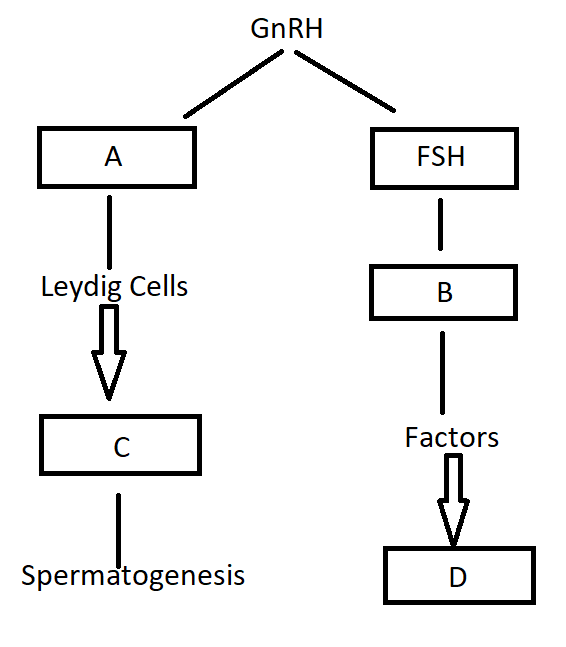
Application-based question-
Identify A, B, C and D with reference to gametogenesis in humans, in the flow chart given below


Answer
576k+ views
Hint: Gametogenesis is under the effect of hormones from the hypothalamus and anterior pituitary.
Complete Answer:
(i) Luteinising hormone (LH) or interstitial cell-stimulating hormone (ICSH) is a glycoprotein hormone which is secreted by the anterior lobe of the pituitary gland under the effect of Gonadotropin-releasing hormone (GnRH) from the hypothalamus. It helps in the growth and maturation of Graafian follicles. Along with follicle-stimulating hormone (FSH) it is known to promote ovulation. It also helps to maintain the second or secretory phase of the menstrual cycle.
(ii)It is known to control the secretion of progesterone by corpus luteum. In males, LH is called ICSH which helps to activate interstitial or Leydig's cells of testes to secrete testosterone and other androgens.
(iii) The Sertoli cells are present inside the seminiferous tubules of the testis.
- FSH stimulates cells to form androgen-binding protein (ABP) through Sertoli cells and initiates the system of spermatogenesis. These cells are also known to provide nutrition to the developing sperm cells and are regulated under the effect of FSH.
- Sertoli cells are also called the nurse cells.
- Testes are present in the scrotum and secrete male sex hormones called androgens of which testosterone is a type. Androgens are released from the group of interstitial cells or Leydig cells which are present in the connective tissue between seminiferous tubules.
- The Leydig cells are stimulated to release testosterone under the effect of luteinising hormone from the anterior pituitary gland.
- Spermiogenesis is the last stage of spermatogenesis, there may be maturation of spermatids into spermatozoa.The spermatids are circular in structure with a nucleus, Golgi apparatus, centriole and mitochondria. All these components take part in forming the spermatozoon along with development of tail for movement.
Thus, the answer is A-LH, B-Sertoli cells, C- Testosterone, D- Spermiogenesis.
Note: In females, gametogenesis initiates during embryonic development. The Primordial germ cells begin to migrate into the ovaries after four weeks of improvement and begin differentiating into oogonia (46,2N).
Complete Answer:
(i) Luteinising hormone (LH) or interstitial cell-stimulating hormone (ICSH) is a glycoprotein hormone which is secreted by the anterior lobe of the pituitary gland under the effect of Gonadotropin-releasing hormone (GnRH) from the hypothalamus. It helps in the growth and maturation of Graafian follicles. Along with follicle-stimulating hormone (FSH) it is known to promote ovulation. It also helps to maintain the second or secretory phase of the menstrual cycle.
(ii)It is known to control the secretion of progesterone by corpus luteum. In males, LH is called ICSH which helps to activate interstitial or Leydig's cells of testes to secrete testosterone and other androgens.
(iii) The Sertoli cells are present inside the seminiferous tubules of the testis.
- FSH stimulates cells to form androgen-binding protein (ABP) through Sertoli cells and initiates the system of spermatogenesis. These cells are also known to provide nutrition to the developing sperm cells and are regulated under the effect of FSH.
- Sertoli cells are also called the nurse cells.
- Testes are present in the scrotum and secrete male sex hormones called androgens of which testosterone is a type. Androgens are released from the group of interstitial cells or Leydig cells which are present in the connective tissue between seminiferous tubules.
- The Leydig cells are stimulated to release testosterone under the effect of luteinising hormone from the anterior pituitary gland.
- Spermiogenesis is the last stage of spermatogenesis, there may be maturation of spermatids into spermatozoa.The spermatids are circular in structure with a nucleus, Golgi apparatus, centriole and mitochondria. All these components take part in forming the spermatozoon along with development of tail for movement.
Thus, the answer is A-LH, B-Sertoli cells, C- Testosterone, D- Spermiogenesis.
Note: In females, gametogenesis initiates during embryonic development. The Primordial germ cells begin to migrate into the ovaries after four weeks of improvement and begin differentiating into oogonia (46,2N).
Recently Updated Pages
A man running at a speed 5 ms is viewed in the side class 12 physics CBSE

The number of solutions in x in 02pi for which sqrt class 12 maths CBSE

State and explain Hardy Weinbergs Principle class 12 biology CBSE

Write any two methods of preparation of phenol Give class 12 chemistry CBSE

Which of the following statements is wrong a Amnion class 12 biology CBSE

Differentiate between action potential and resting class 12 biology CBSE

Trending doubts
What are the major means of transport Explain each class 12 social science CBSE

Which are the Top 10 Largest Countries of the World?

Draw a labelled sketch of the human eye class 12 physics CBSE

How much time does it take to bleed after eating p class 12 biology CBSE

Explain sex determination in humans with line diag class 12 biology CBSE

Explain sex determination in humans with the help of class 12 biology CBSE




